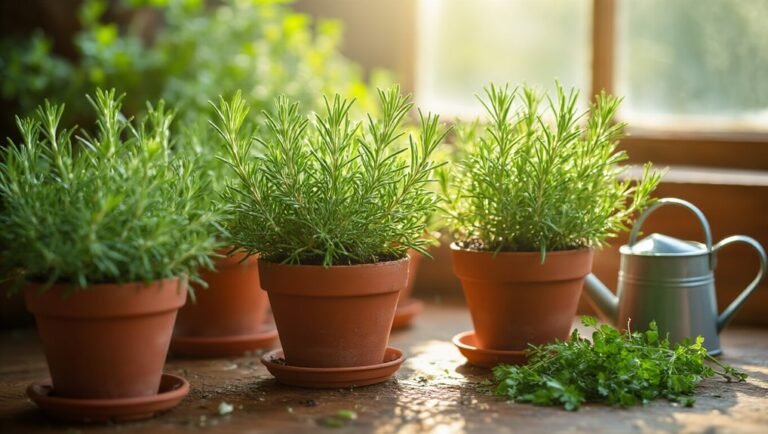The #1 secret to improving heavy clay soil is adding organic matter. It transforms your dense, compacted earth into a workable and fertile medium. By mixing in compost or mulch, you enhance drainage, boost nutrient retention, and create a thriving environment for beneficial microorganisms. This simple step can dramatically improve your plants’ health and resilience. Want to know more techniques to optimize your clay soil? You’ll discover valuable tips ahead.
Key Takeaways
- Add organic matter, such as compost, to transform heavy clay into a fertile and workable soil medium.
- Incorporate gypsum to break up compacted clay and improve drainage significantly.
- Plant cover crops in off-seasons to enhance soil nutrients and prevent erosion.
- Use mulch to regulate soil temperature and moisture levels effectively.
- Test soil health regularly to monitor nutrient levels and identify pest or disease issues.
Understanding Heavy Clay Soil
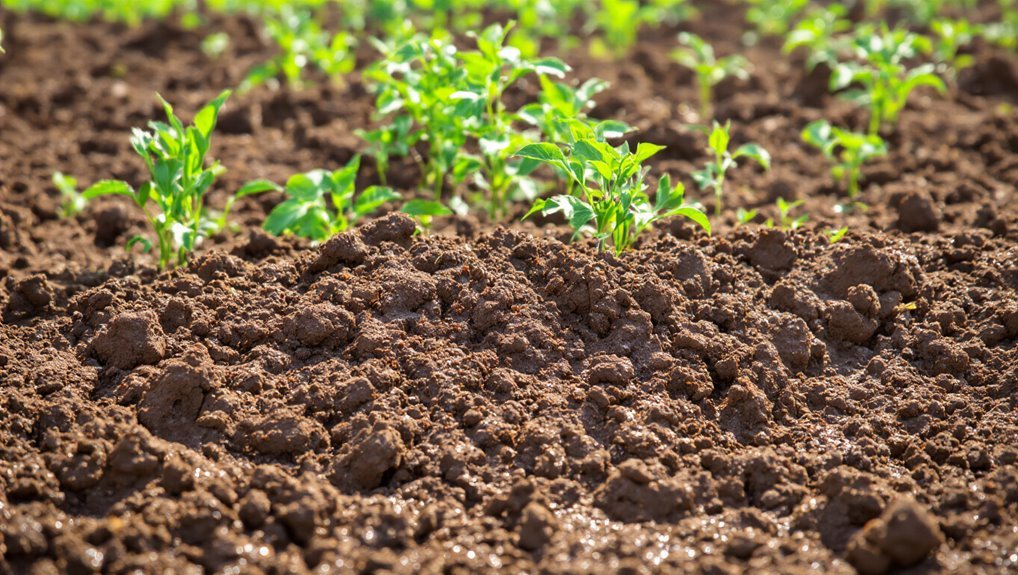
Heavy clay soil can be a gardener’s challenge, but understanding its unique properties can make a big difference. This soil type is dense and sticky, retaining moisture and nutrients but often draining poorly.
You’ll notice it compacts easily, which can hinder root growth and lead to waterlogging. Recognizing its high mineral content, particularly iron and aluminum, helps you appreciate its fertility potential. Many gardeners find that adding organic mulching materials can further boost the structure and fertility of heavy clay soils.
However, you must also be aware that heavy clay can become hard and cracked in dry conditions, making it difficult for plants to thrive. By understanding these characteristics, you can better tailor your gardening practices, choosing the right plants and amendments to improve its overall health and productivity.
One highly effective way to address these challenges is by using mulch to improve moisture retention and enhance soil structure. Embrace this knowledge, and you’ll transform your gardening experience.
The Importance of Soil Structure
Soil structure plays a crucial role in determining how well your garden flourishes, especially when dealing with heavy clay.
When you improve soil structure, you enhance the overall health of your garden. Here’s why it matters:
- Water Drainage: Well-structured soil allows excess water to drain, preventing root rot.
- Aeration: Good soil structure promotes air circulation, essential for root growth.
- Nutrient Availability: It helps in better nutrient retention and access for plants.
- Microbial Activity: A healthy structure supports beneficial microorganisms that enrich the soil.
Adding organic matter through outdoor composting systems is one of the most effective ways to improve the structure and fertility of heavy clay soils.
Choosing the right garden soil can make a significant difference in improving the structure and performance of heavy clay soils.
Benefits of Amending Clay Soil
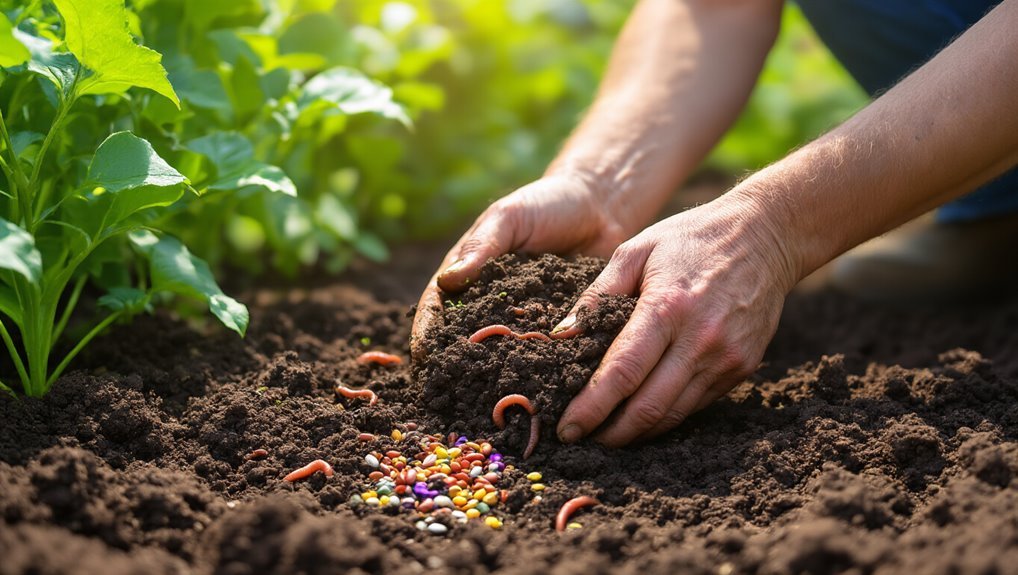
Improving the structure of your garden’s soil can lead to significant benefits when it comes to amending clay soil. By enhancing drainage, you reduce waterlogging, which helps prevent root rot and promotes healthier plants.
Better aeration allows roots to access oxygen more easily, fostering strong growth. You’ll also notice improved nutrient availability, as amended clay soil retains essential minerals while allowing excess water to escape. This balance encourages vibrant plant life and more productive gardens. For gardeners looking for an efficient way to create rich organic matter, compost tumblers provide a convenient solution for turning yard waste and kitchen scraps into nutrient-rich compost.
Additionally, by amending clay soil, you create a more resilient environment that withstands extreme weather conditions, whether it’s heavy rain or drought. One effective way to enrich clay soil is by using compost bins, which help break down organic matter and supply valuable nutrients to your garden.
The #1 Secret: Adding Organic Matter
While many strategies exist for enhancing clay soil, adding organic matter remains the most effective secret. This simple yet powerful practice transforms heavy clay into a more workable and fertile medium.
By incorporating organic matter, you improve soil structure, drainage, and nutrient availability. Here’s what adding organic matter can do for your clay soil:
- Enhances drainage by breaking up compacted particles
- Increases nutrient retention for healthier plants
- Encourages beneficial microorganisms that support plant growth
- Improves aeration, allowing roots to breathe
Whether you use compost, well-rotted manure, or leaf mold, introducing organic matter will significantly boost your garden’s health. For even better results, consider using a soil sifter or screen to remove debris and create finer compost before mixing it into your clay soil.
For gardeners who compost at home, using a compost thermometer can ensure your compost is reaching the ideal temperature for breaking down organic matter effectively.
Embrace this secret and watch your clay soil thrive!
How to Properly Incorporate Organic Matter
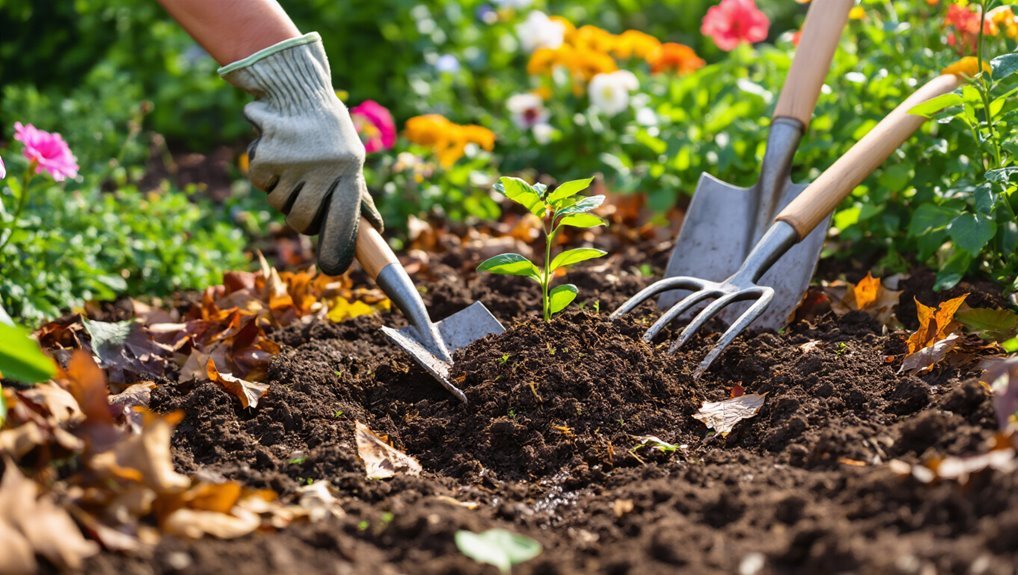
To effectively incorporate organic matter into heavy clay soil, start by assessing the area you want to amend. Clear the surface of any debris, weeds, or rocks.
Next, choose your organic material—compost, well-rotted manure, or leaf mold work great. Spread a layer about 2 to 4 inches thick over the soil.
Using a garden fork or tiller, mix the organic matter into the top 6 to 12 inches of soil. This process helps break up the clay and improves drainage.
Water lightly to settle the materials and enhance microbial activity. Repeat this process annually to maintain soil health.
With time and effort, your heavy clay soil will transform into a more fertile and workable environment for your plants.
Additional Tips for Managing Clay Soil
Incorporating organic matter is just one step in managing heavy clay soil effectively. Here are a few additional tips to enhance your soil’s structure and drainage:
- Use gypsum to help break up compacted clay and improve drainage.
- Plant cover crops like clover or vetch during off-seasons; they’ll add nutrients and prevent erosion.
- Avoid tilling when the soil is wet; this can lead to further compaction.
- Mulch your garden beds to regulate temperature and moisture, reducing the impact of heavy rains.
Monitoring and Maintaining Soil Health
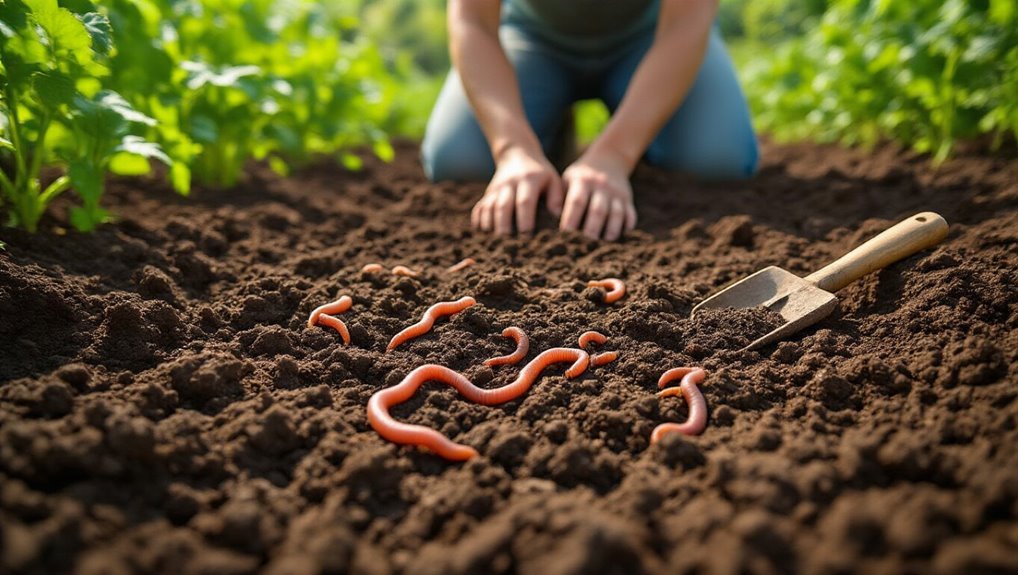
Monitoring and maintaining soil health is crucial for ensuring your garden thrives, especially when dealing with heavy clay. Start by regularly testing your soil’s pH and nutrient levels. You can use a simple soil test kit to get accurate readings.
Based on the results, amend your soil with organic matter like compost or well-rotted manure to enhance drainage and fertility.
Keep an eye on soil structure and moisture levels. If it feels compacted or waterlogged, consider aerating it or planting cover crops to improve airflow.
Regularly check for pests and diseases, as they can indicate underlying soil issues. Finally, practice crop rotation to prevent nutrient depletion and maintain a balanced ecosystem in your garden.
Your efforts will pay off with healthier plants!
Frequently Asked Questions
How Long Does It Take to See Improvements in Clay Soil?
You’ll typically see improvements in clay soil within a few months after making changes. Factors like weather, type of amendments used, and consistency in care all influence how quickly your soil will improve.
Can I Use Any Type of Organic Matter?
Absolutely, you can use various organic matter types, like compost or aged manure. Think of it as a nourishing feast for your soil, helping to break up the clay and improve drainage and fertility.
What Tools Do I Need for Incorporating Organic Matter?
You’ll need a shovel for turning the soil, a rake for leveling, and a garden fork for breaking up clumps. A wheelbarrow makes transporting organic matter easier too. Grab these tools, and you’re set!
Is There a Best Time of Year for Amending Clay Soil?
Yes, the best time for amending clay soil is in the fall or spring. This allows organic matter to break down during the winter or summer, improving soil structure and drainage when you’re ready to plant.
How Do I Test My Clay Soil’s Ph Level?
Wondering how to test your clay soil’s pH level? Grab a soil test kit from your local garden center, follow the instructions, and you’ll get accurate results to help you improve your soil’s health.
Conclusion
Improving heavy clay soil doesn’t have to be a daunting task. By adding organic matter, you can transform your garden into a thriving oasis. Did you know that just 5% organic matter can significantly enhance soil structure, water retention, and nutrient availability? Incorporating this simple secret can lead to healthier plants and a more vibrant garden. Keep monitoring and maintaining your soil health, and you’ll enjoy the benefits for years to come. Happy gardening!
